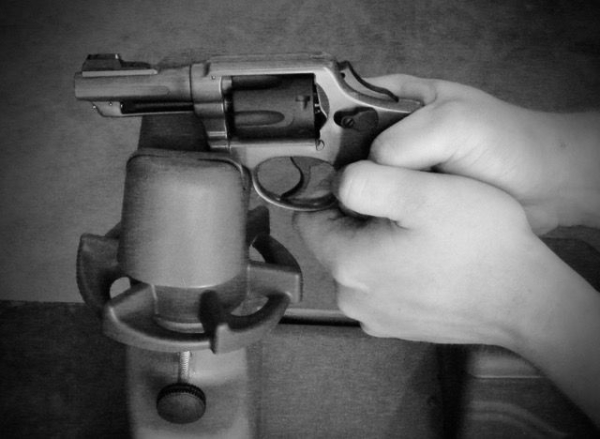When checking accuracy with a firearm, both pistol and long gun it’s a good idea to remove as many of the “human” factors as possible. The more stable the platform, the better the accuracy. Our bodies shake and wobble, there’s no way around it. Plus, the steadier we try to hold the gun on target the worse the shake/wobble becomes. This is where shooting rests come to our rescue.
Accuracy relies on stability, the more the better. There are two primary ways to create a steadier platform. You can lower your center of gravity. A kneeling position is more stable than standing/offhand. And/or, you rest or brace against something. A “braced” kneeling position, with the support arm’s elbow resting against the support knee increases accuracy. You can use a tree to brace the hand against, supporting the handguard like when bridging a pool cue.

A shooting rest is great for checking accuracy on the range. Rests come in all flavors. There are bags, normally a front and rear bag, that are filled with dense materials and to a certain degree can be formed to fit your needs. Structured rests have front, rear and sometimes a middle rest depending on design that are all connected.
A “sled” is normally heavier, relying on weights to reduce movement between shots, or may be bolted down to a shooting bench. The firearm is clamped into the rest, and firing is done through a mechanical means of stroking or pressing the trigger. These are the ultimate rest, but are also the most expensive.
Rests are used to check the firearm’s mechanical accuracy. They help establish how tight a group the gun can produce. For zeroing, it’s best to add the human element back into the equation.
Usually, and almost always with rifles, the bullet’s point of impact will shift according to how the gun is supported when fired. We all “shoot” differently. How we “see” sights, the way we press the trigger, the recoil against our body and many other factors affect where the bullet strikes in relation to the point of aim. The only way to zero your gun is while you’re firing it. I’m not big on zeroing weapons off a shooting bench, but if you do then check your results by actually firing from the various field positions you’re using.
Pretty much all firearms are more accurate than we can shoot them. Sure, maybe the sights aren’t aligned perfectly and at sixty yards I have to aim my .380 Ruger LCP two feet low and five feet right, but it still shoots a decent group at that distance. And it’s way more accurate than I could fire it under actual defensive conditions.
Knowing your gun is accurate – and reliable – removes a big “worry” about shooting accurately. Shooting rests help establish what your gun’s capable of accuracy wise. Just keep in mind, they also remove the old excuse, “This thing won’t hit a barn at ten feet.” After confirming the weapon’s accuracy, it’s all on you to apply the fundamentals – Aim, Hold, Press and Follow Through – to ensure the proper placement of the hit on target.
Tiger McKee is director of Shootrite Firearms Academy. He is the author of The Book of Two Guns, AR-15 Skills and Drills, has a regular column in American Handgunner and makes some cool knives and custom revolvers. www.shootrite.org or visit Shootrite’s Facebook page for other details.